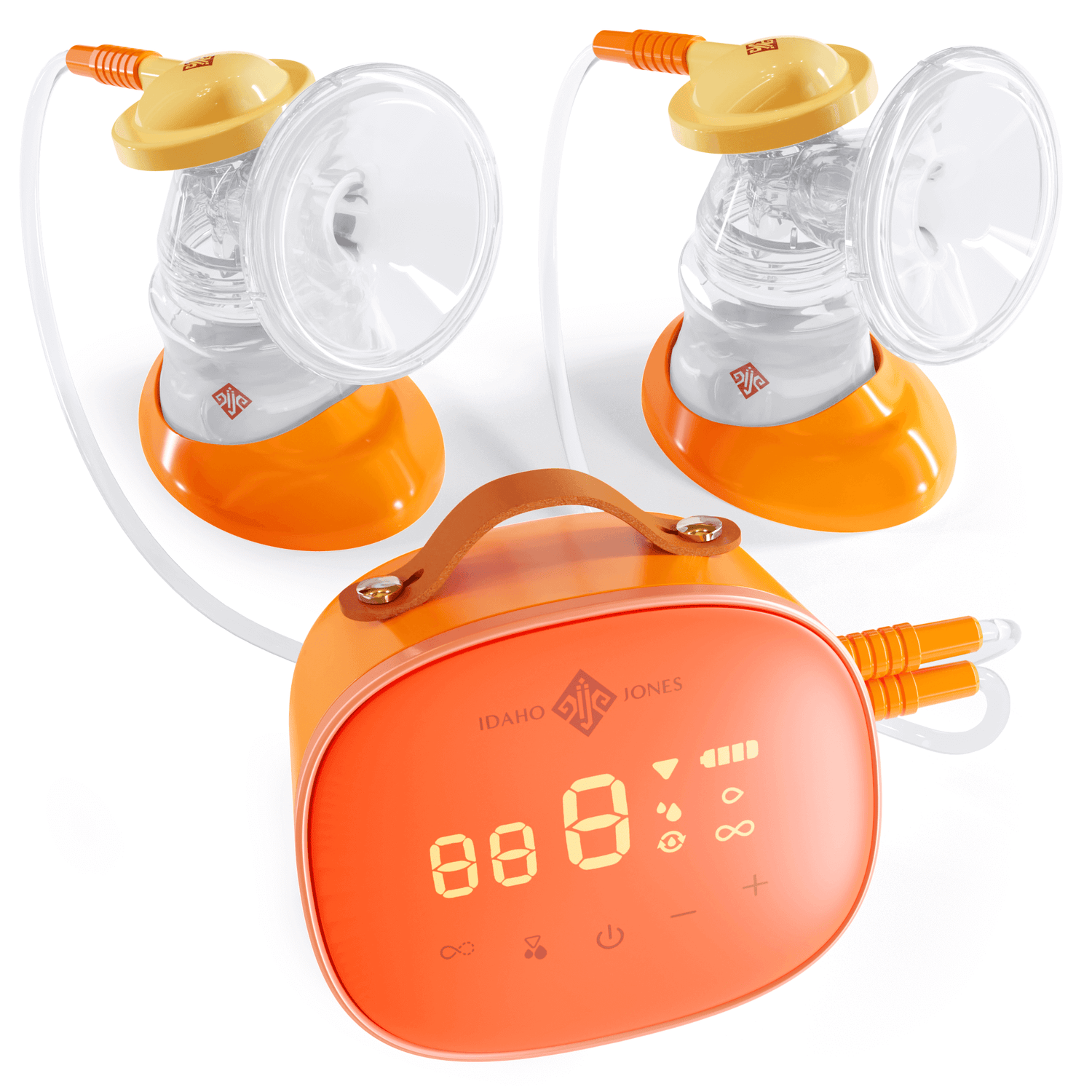For many moms, especially first timers, knowing when and how to start pumping breast milk can be confusing. In this post, we’ll guide you through some of the times you might want to start pumping or expressing your milk—and everything you need to get started. Everyone’s journey is different, so don’t hesitate to consult with a provider for specific advice on your situation and goals. Whether you start pumping or expressing your breast milk prenatally or minutes, days, or month’s after giving birth, there are a variety of techniques, resources, and tools that can help you remove and save your milk with ease.
Ways to Express Milk
A pump is like what you think of when you consider removing or “expressing” breast milk from your body. One of the more common tools, pumps come in a variety of shapes, brands, and sizes, and it may take some trial and error to find the pump that’s right for you. You may find that you have different pumps for different times or purposes. Many people in the United States get a breast pump through their insurance, so obtaining one prenatally is common. Because of the Patient Protection and Affordable Care Act of 2010 (ACA)—described here by the American Academy of Pediatrics (AAP)—insurance companies (with a few exceptions) are required to cover the cost of breast pump rental and purchase at low or no cost to consumers, so which pumps are covered may be one of the factors in choosing a pump to start with.
There are also a variety of tools that help you collect milk that’s dripping from the breast. Not to be confused with pumps that mimic an infant suckling, devices like the Haaka create a vacuum and may be useful for collecting milk. However, these silicone “pumps” can contribute to issues like oversupply or low weight gain, so if you’re unsure about using one of these devices, consult an IBCLC or other breastfeeding professional.
Additionally, you can remove milk from your breasts with another one of your very own body parts...your hands! Hand expression is great in a pinch, and some moms rely on it as the main way to express their milk or as a way to help more milk flow while pumping.
Depending on where you are in your pumping journey, one technique of milk expression might be a better fit, or a mix of methods that helps you get just the right amount of breast stimulation—for you (and your milk supply!)—and milk—for your baby.
What are Your Goals?
When getting started with anything, it’s important to consider your goals. Mothers pump for a number of reasons. Both for motivation and as you decide how often and how much to pump, it’s important to consider your “why” behind pumping. Some common reasons include:
- Having extra breast milk on hand so another parent or caregiver can help with feeding the baby
- Feeding a baby (or babies) in the NICU
- Supplementing your baby with your own milk because they are struggling to transfer enough milk (because of a tongue or lip tie, pre- or near-term birth, etc.)
- Boosting milk supply
- Returning to work
- Inducing lactation
Prenatally
Many pregnant women are curious when they can start pumping or expressing milk. Generally expressing milk before full term (37 weeks gestation) is discouraged, because breast stimulation could induce preterm labor, since it increases oxytocin which is part of the body’s way of causing uterine contractions. However, after 37 weeks gestation, studies have found that it is generally safe to express milk and can be a helpful way to ensure breastfeeding success after your baby is born. Some mothers like the reassurance they are “building a stockpile of milk ahead of birth and that milk would be available immediately if their infant required it.” If you are interested in prenatal milk expression, check with your doctor or midwife to be sure that you don’t have any contraindications. Colostrum is the first milk your body makes and you start producing it around weeks 16-22 of pregnancy. Hand expression, or pumping with lots of hands-on massage can be more effective at removing colostrum than pumping alone.
Immediate Postpartum
If your baby is with you immediately after birth, you can offer them “first dibs” on your milk. Breastfeeding is a two-way relationship, and giving your baby plenty of time at the breast, especially in the early days can be a great way to bond with them and let your baby learn how to feed effectively and comfortably. However, if you’re separated from your baby or if they aren’t breastfeeding, pumping in the immediate postpartum can be an important step in establishing your milk supply. If you’re at a hospital, they likely have a hospital-grade electric pump that you can use. KellyMom recommends pumping within the first six hours after birth if you’re separated from your baby.
Complications
For many mother-baby dyads where one or both are experiencing some sort of complication, pumping can be a crucial part of nutrition, bonding, and healing. Many moms find the act of providing milk for their baby very meaningful, even if they aren’t able to directly breastfeed at first or ever. Complications can range from a maternal health issue like preeclampsia or postpartum hemorrhage as well as infant complications like jaundice, a NICU stay, and cleft lip or palate. If you’re experiencing or anticipating any complications, getting breastfeeding and pumping support from a lactation consultant can help make things easier for you and your baby, as well as support you in reaching your breastfeeding and lactation goals.
Postnatally
Many moms start pumping to build up a supply of milk that can be used by other caregivers, if they’re traveling, or when they return to work. Oversupply is a common issues for pumping moms, and when you imagine your ideal “milk stash” you might picture an entire freezer full of bags or jars or milk. This can feel daunting and there’s good news: you may not need as much as you think. Many breastfeeding moms make do with as little as 1-2 days worth of milk in the refrigerator or freezer. Especially if you’ll pump more each day to replenish what your baby drinks in a day, a small stash can mean you’re prepared without adding extra stress or work to your plate. It’s also important to note that some mothers never pump. Choosing when and how often to pump will depend on your baby’s needs, your body, your lifestyle, and your family’s goals and preferences. It’s also never too late to start pumping—if your situation changes and you need or want to begin pumping, it’s possible to add it to your breastfeeding routine, even if your baby is a year or older. Additionally, pumping can be used postnatally to relactate if you and your baby have stopped breastfeeding and you decide at some point to try again.
Return to Work
The return to work is a big reason that many moms start pumping. If that’s why you’re pulling out a pump for the first time or practicing hand expression, you’re in good company. As you prepare for this transition, here are some things to keep in mind, based on a post on “Working and Breastfeeding” from La Leche League International:
- Enjoy your baby first. Whatever time you have away from work, make bonding with your baby, establishing breastfeeding (if that’s how you’re feeding your baby), and resting so your body can heal first priority.
- If your baby has yet to take a bottle, begin pumping and offering bottles once your milk supply is well-established, around 4 weeks postpartum.
- Acknowledge that the transition back to work is a big one—for you and your baby. You will miss each other, and feeling emotional about this new experience is normal.
- Know your rights when it comes to pumping in the workplace. (Policies and laws pertaining to new mothers can be found here for the US and here for the UK.)
- Make yourself as comfy as possible when pumping at work—maybe try meditation or looking at a photo of baby while you pump or express your milk.
Just like the uniqueness of individual breasts or babies, pumping looks different for each and every person. Whether you’re pumping sooner than you expected to because of a health complication, are preparing to pump at work for the first time, or have lost your unopened breast pump in a closet somewhere, the work that goes into making milk for your baby is valuable...and time-consuming!



